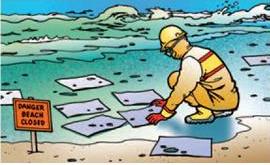View the steps below and familarize yourself on what to do during emergency preparedness when it comes to hazardous materials.
Before
.jpg) Add plastic sheeting, duct tape, masks and gloves, and scissors to your emergency supplies kit.
Add plastic sheeting, duct tape, masks and gloves, and scissors to your emergency supplies kit.
During
- If authorities ask you to evacuate, do so immediately. Stay tuned to local news for evacuation routes, temporary shelters, and procedures. If you have time, reduce potential contamination in the house by closing all the windows, shutting all the vents, and turning off any ventilation fans. Take your emergency supplies kit with you. Help neighbors who may need special assistance.
- If you are caught outside, stay upstream, uphill, and upwind. Try to get at least one-half mile or eight to 10 city blocks from the danger area. Move away from the incident scene, and help keep others away. Do not walk into or touch any spilled liquids, airborne mists, or condensed solid chemical deposits. Try not to inhale gases, fumes, or smoke. If possible, cover your mouth with a cloth. Stay away from accident victims until the hazardous material has been identified.
- If you are in a motor vehicle, stop and seek shelter in a permanent building. If you must remain in your car, keep the windows and vents closed, and shut off the air conditioner and heater.
- If authorities ask you to stay inside, bring your pets in, as well. Close and lock all exterior doors and windows. Close the vents, fireplace dampers, and as many interior doors as possible. Turn off air conditioners and ventilation systems. Go into a pre-selected shelter room, which should be above ground and have the fewest openings to the outside. Seal gaps under doorways and windows with wet towels or plastic sheeting and duct tape. Seal gaps around window air conditioning units, bathroom and kitchen exhaust fans, and stove and dryer vents with duct tape and plastic sheeting, wax paper, or aluminum foil. Use material to fill cracks and holes in the room, such as those around pipes. If gas or vapors could have entered the building, take shallow breaths through a cloth or a towel. Avoid eating or drinking any potentially contaminated food or water.
- In a sealed shelter room, 1 meter sq / 10 square feet of floor space per person will provide sufficient air to prevent carbon dioxide buildup for up to five hours, assuming a normal breathing rate while resting. Officials are unlikely to recommend shelter in a sealed room for more than two to three hours, however, because the contaminated outside air gradually seeps into the shelter. At this point evacuation is the better choice.
After
 Ventilate the shelter when the emergency has passed to avoid breathing contaminated air still inside.
Ventilate the shelter when the emergency has passed to avoid breathing contaminated air still inside.
- Return home only after authorities say it is safe. Open windows and vents and turn on fans to provide ventilation.
- If you have come in contact with or have been exposed to hazardous chemicals, act quickly and do the following: Follow decontamination instructions from local authorities. You may be advised to take a shower, or you may be told to stay away from water. Seek medical treatment for unusual symptoms as soon as possible. Place exposed clothing and shoes in tightly sealed containers. Do not allow them to come in contact with other materials. Call local authorities to find out about proper disposal. Advise anyone who comes into contact with you that you may have been exposed to a toxic substance.
- Find out from local authorities how to clean up your land and property.
- Report any lingering vapors or other hazards to your local emergency services office.
Developed by NFPA. Funding provided by the U.S. Department of Homeland Security, Office of Domestic Preparedness.